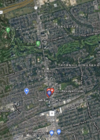But there are NIMBY types along the rest of the line - which is why, just like Sheppard, most of the line is probably not going to see a lot of development.
These two things don't necessarily add up. Yes, there will be some NIMBYs but most people know the development is coming. I'm not really worried it won't happen. The Markham plans aren't finalized but have been in progress for years and the Vaughan Secondary Plan was approved 10 years ago; people know the deal.
The first few developments, proposed for Yonge/Steeles, have drawn attention but understandably as they're huge and the subway is still a decade away. But I have zero concerns the density will materialize. Time will tell.
The area you're referring to for density is surrounded by a lot of large subdivisions. It isn't terribly large, and I can't help but question what kind of density we'll see there, and it's form.
I'm not sure which area you're talking about specifically. Starting at the south end:
-Yonge/Steeles is already seeing mega-proposals (multiple towers, 50-60 storeys) that will extend pretty much all the way to Hilda Ave along Steeles and the car dealerships and strip malls will soon be gone, and the people know that. As I said above, the first few developments are already in excess of what was approved in Vaughan's SP for the area, and I agree that the sheer scale of what they're asking is excessive and residents are right to point it out. But I wouldn't say they're being NIMBY's. It'll mostly be condos, no question, but there will be some office and retail mixed in.
-Yonge/Clark only has subdivision on the east side of Yonge, really. You can see, pretty clearly, where the intensification there will happen. Probably it'll go up to Elgin, where the Farmer's Market is.
-Then there will be a break for the heritage district and the valley. The rest depends a bit on what happens with Royal Orchard. It's a wild card because who knows what will happen with that large site at Royal Orchard if there is no station... but let's assume there is one. Residents know that's gonna be a package deal: subway station + mega development on that site. Then there are strip malls to the north and you're right; they're relatively shallow lots until you get closer to 407 and there will be some pushback, perhaps but again: Markham knows the trade-off they're agreeing to if that station goes in.
I guess I should add a map, to have handy here. (I just made little Xs for the stations).
And, more to the point, this line has something Sheppard doesn't: a couple of hundred of blank-slate acres at the end of the line, ready and waiting for highrise development, wall to wall. That's where most of the development will go, including the vast majority of any employment uses, and that's the pot of gold at the end of the rainbow, the larger corridor will have a decent amount to supplement that. There are some neigbhourhoods north and west of the of the growth centre but they also know what's coming. All the NIMBYs in the world won't put it a dent in it. The Provincial policy is set in stone so even if council, which has supported density there, gets cold feet, the LPAT will shoot them down every time.
Anyway, you can question it but I'd have a look at what is going on north of 7, on either side of 16th. Particularly on the south side of 16th, where there are subdivisions set back not too far from Yonge.
In any case, I have to echo what
@44 North mentioned earlier:
I blocked that dude many moons ago and can't see his posts but I'm sure he has nothing to say I'd find interesting.

